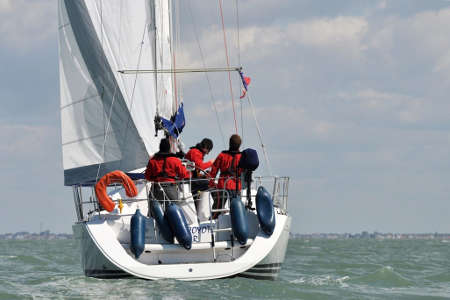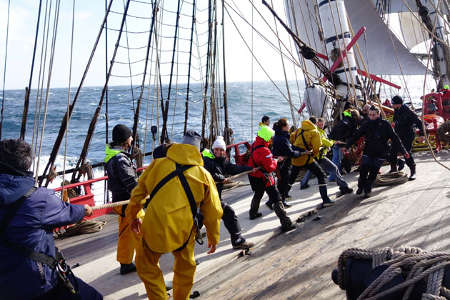Why buy a sailboat instead of a motorboat? Beyond the absence of noise, the true charm of our winged steeds lies in the art of maneuvering them. This ancient heritage connects us to the history of humanity and synthesizes centuries of evolution in their mastery of the sea.
For those who experience them, the gestures and nautical terms are more valuable than books, as they truly integrate only through action. Maneuvers, therefore, carry a nobility that reflects the humility they demand in the face of natural constraints, an essential contribution to the beauty of sailing. This is likely why a well-executed maneuver always commands respect.
Of course, maneuvers have been simplified over the course of history.
In the age of sail-powered navies, it took several years to train a skilled sailor capable of finding their way in the labyrinth of rigging and sails with increasingly peculiar names. In the 18th century, a frigate like the Hermione required an hour and a half of work from about thirty men to execute a simple tack. Everything was slower but also more dangerous, as even the smallest mistake carried enormous risks for navigation. Failing to tack could drive a ship ashore, endangering its crew and cargo. These high stakes demanded perfect coordination, iron discipline, and mastery from officers and boatswains.
In the 19th century, sailors working nearly fifty meters above the deck on clippers racing at full speed through the swells of high latitudes faced certain death in the event of an error. Coastal working boats also posed significant risks for sailors, who often had to steer with tackles and handle several dozen square meters of sails using only rudimentary pulleys. This exhausting task was compounded by the challenges of fishing in regularly hostile conditions...
In the 20th century, the rise of recreational sailing prompted designers to equip boats with so-called "Marconi" rigs, named after the inventor of masts used to emit the first radio waves. These stayed masts gained height and were equipped with triangular sails inspired by 17th-century Bermudian vessels. This innovation improved the weight-to-power ratio, allowing boats to perform better in light winds and gain precious degrees when sailing upwind. More importantly, the Marconi rig simplified maneuvers, requiring fewer spars (such as yards) to handle, fewer ropes, and therefore less work. This significantly reduced maneuvering time, perfectly aligning with the spirit of recreational sailing.
Over the years, the influence of competitive sailing has enhanced the "wardrobe" of recreational boats with sails like spinnakers, asymmetrical spinnakers, gennakers, and other "code 0" sails. This evolution satisfies our desire to maneuver, delivering ever greater performance.


Today, the most dreaded basic maneuver among sailors is undoubtedly the jibe. This maneuver allows you to switch from one tack to the other with the wind at your back.
The downside: the boom (the horizontal bar at the base of the mainsail) tends to sweep across the deck violently, or even very violently if its movement is not properly controlled.
In medium winds and above, an uncontrolled jibe can cause significant material and human damage. It is a fairly simple maneuver to perform... provided you keep a close eye on things.
Simply changing direction on a sailboat involves all kinds of maneuvers that need to be mastered perfectly. But before hoisting the sails, you first need to cast off.
It is during harbor maneuvers that most collisions occur. This isn’t surprising, as these involve making turns and various adjustments in a confined space, often complicated by wind, currents, and sometimes heavy traffic...
The opposite of a jibe, tacking involves switching from one tack to the other while facing the wind.
This maneuver is much more forgiving for the absent-minded, as those with their heads in the clouds are less likely to lose them in the process. However, it’s still important to remember its sequence to move effectively on the water.
Why buy a sailboat instead of a motorboat? Beyond the absence of noise, the true charm of our winged steeds lies in the art of maneuvering them. This ancient heritage connects us to the history of humanity and synthesizes centuries of evolution in their mastery of the sea.
For those who experience them, the gestures and nautical terms are more valuable than books, as they truly integrate only through action. Maneuvers, therefore, carry a nobility that reflects the humility they demand in the face of natural constraints, an essential contribution to the beauty of sailing. This is likely why a well-executed maneuver always commands respect.
Of course, maneuvers have been simplified over the course of history.
In the age of sail-powered navies, it took several years to train a skilled sailor capable of finding their way in the labyrinth of rigging and sails with increasingly peculiar names. In the 18th century, a frigate like the Hermione required an hour and a half of work from about thirty men to execute a simple tack. Everything was slower but also more dangerous, as even the smallest mistake carried enormous risks for navigation. Failing to tack could drive a ship ashore, endangering its crew and cargo. These high stakes demanded perfect coordination, iron discipline, and mastery from officers and boatswains.
In the 19th century, sailors working nearly fifty meters above the deck on clippers racing at full speed through the swells of high latitudes faced certain death in the event of an error. Coastal working boats also posed significant risks for sailors, who often had to steer with tackles and handle several dozen square meters of sails using only rudimentary pulleys. This exhausting task was compounded by the challenges of fishing in regularly hostile conditions...
In the 20th century, the rise of recreational sailing prompted designers to equip boats with so-called "Marconi" rigs, named after the inventor of masts used to emit the first radio waves. These stayed masts gained height and were equipped with triangular sails inspired by 17th-century Bermudian vessels. This innovation improved the weight-to-power ratio, allowing boats to perform better in light winds and gain precious degrees when sailing upwind. More importantly, the Marconi rig simplified maneuvers, requiring fewer spars (such as yards) to handle, fewer ropes, and therefore less work. This significantly reduced maneuvering time, perfectly aligning with the spirit of recreational sailing.
Over the years, the influence of competitive sailing has enhanced the "wardrobe" of recreational boats with sails like spinnakers, asymmetrical spinnakers, gennakers, and other "code 0" sails. This evolution satisfies our desire to maneuver, delivering ever greater performance.


Today, the most dreaded basic maneuver among sailors is undoubtedly the jibe. This maneuver allows you to switch from one tack to the other with the wind at your back.
The downside: the boom (the horizontal bar at the base of the mainsail) tends to sweep across the deck violently, or even very violently if its movement is not properly controlled.
In medium winds and above, an uncontrolled jibe can cause significant material and human damage. It is a fairly simple maneuver to perform... provided you keep a close eye on things.
Simply changing direction on a sailboat involves all kinds of maneuvers that need to be mastered perfectly. But before hoisting the sails, you first need to cast off.
It is during harbor maneuvers that most collisions occur. This isn’t surprising, as these involve making turns and various adjustments in a confined space, often complicated by wind, currents, and sometimes heavy traffic...
The opposite of a jibe, tacking involves switching from one tack to the other while facing the wind.
This maneuver is much more forgiving for the absent-minded, as those with their heads in the clouds are less likely to lose them in the process. However, it’s still important to remember its sequence to move effectively on the water.